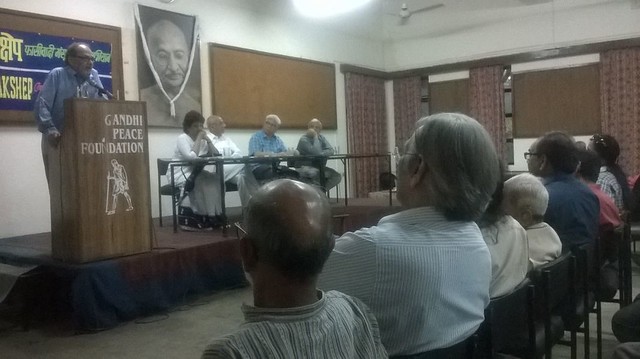By TwoCircles.net special correspondent,
New Delhi: A day after international rating agency Moody’s raised India’s credit rating outlook from stable to positive, a group of doctors, senior lawyers and journalists gathered in New Delhi to share their anguish in the backdrop of a lower court judgment holding no one guilty of the infamous Hashimpura massacre in which 42 Muslims were killed in cold blood allegedly by cops belonging to the Provincial Armed Constabulary (PAC).
Senior journalist Saeed Naqvi poured his hear out. “What is happening in this country? Whom should we trust?” questioned Naqvi, while pointing fingers on the role of police and judiciary in dealing with the Hashimpura case. “One day a group of policemen kills 20 innocent people calling them smugglers (referring to the Chittor incident in Andhra Pradesh last week) and then you have politicians spewing venom every now and then,” said Naqvi talking about gross human rights violations in India.

The discussion Janhastakshep: A campaign against Fascist Designs was organized at the Gandhi Peace Foundation last week in which people from different walks of life expressed their views on the aftermath of Hashimpura judgment. The incident took place in Hashimpura locality in 1987 in Meerut in Uttar Pradesh when the policemen allegedly belonging to PAC killed unarmed Muslims after picking them up from their homes amidst Hindu-Muslim tension. After 28 years of legal battle, the court declared no one guilty due to lack of “proof beyond reasonable doubt”.
But lawyer Rebecca John calls it miscarriage of justice. John, who fought the law suit, says: “The courts look for proof beyond reasonable doubt only when the victim is poor and weak. The benefit of doubt goes always to the aggressor. The police failed in collecting evidence but it was duty of the court to go a step ahead and find the circumstantial evidence to nail the cops. But the judiciary failed in that. The judiciary is as much guilty as the policemen who did shoddy investigation.”
Five survivors of the massacre said they could not identify the killer cops because the cops were wearing helmet and the killing took place in dark night. The entire case fell flat due to this. But legal experts say the judge must have relied on the circumstantial evidence by tracing the PAC truck which carried the victims to the place of killing, weapons used in the firing and other such evidences.
John draws parallel to the incident of a killing of a senior executive of Maruti Udyog Limited by some angry workers of the factory in Gurgaon near Delhi in 2012. Some 145 workers are in jail in this case for the last three years. The courts are refusing bail to them despite no direct evidence against any worker. The executive was killed during an angry protest of workers demanding better work culture. There is no evidence against any one worker who exactly killed the official. Still all 145 workers are in jail.
John says: “Here the courts are asking the poor workers to prove beyond reasonable doubt that they were not involved in the killing of one officer. And in Hashimpura case, the court asked the poor witnesses to prove beyond reasonable doubt who exactly killed 42 people in cold blood.”
“The burden of proof is always with the poor and weak. And it is happening everywhere. There is no accountability.”
Coming back to the Hashimpura case, former Supreme Court judge Justice Rajinder Sachchar said: “It is important that senior officers involved in this crime be booked. Punishing only the constables will not help.”
Lawyer Colin Gonsalves finds a ray of hope. “We have been able to get the Supreme Court order probe into many police encounters in Manipur. Similarly a careful approach is required if we want to appeal the lower court judgment in the high court.

